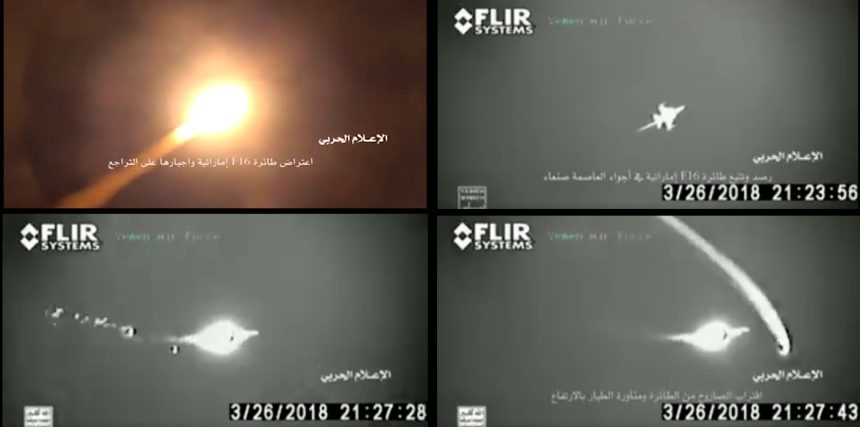Video allegedly shows two UAE Air Force F-16s targeted by Houthi Surface to Air Missiles.
A composite video that includes FLIR footage allegedly showing the attempted shoot down of what should be (based on claims) a flight of two F-16E/F Block 60 of the UAE Air Force flying over Yemen’s capital city of Sanaa has emerged on Mar. 27.
The video shows unidentified missiles being fired at night, whereas the FLIR footage shows the F-16s releasing flares to evade the incoming missile(s). The second part of the clip (with a timestamp dating the incident to Mar. 26 around 21.27 LT) is quite similar to the one released at the beginning of January, when a RSAF F-15 Eagle was targeted (by a modified R-27T based on claims that Houthis have modified a number air-to-air missiles to be launched from pick-ups) and allegedly shot down. At that time the video was alleged to have been obtained using a ground-mounted forward-looking infra-red sensor usually mounted on helicopters for surveillance and targeting: most probably a Flir Systems ULTRA 8500.
The clip released yesterday is also filmed from the right side of the aircraft and shows the aircraft maneuvering (note: 4 minutes before the missiles approaches the alleged UAE Viper), releasing flares and flying through or close to clouds of debris or extinguished decoys. Then you can clearly see the missile narrowly miss the F-16.
The attempted shoot down comes one week after another video showed a modified Russian-made R-27 air-to-air missile allegedly being fired at a Saudi F-15 Eagle (or UAV, according to some sources) has been public.
Official Saudi statement, that confirmed, that the coalition fighter jet was hit by Houthi’s missile R-27 over Saada. Funny thing, that the coalition spokesman blame Iran in smuggling, although these missiles were in possesion by the Yemen Air Forcehttps://t.co/mKKbIY4ZKC pic.twitter.com/emxLfkTFab
— Yuri L (@imp_navigator) March 21, 2018
Noteworthy, along with the modified Vympel R-27T air-to-air missiles, the Houthi rebels may have been delivered some Sayyad 2C Surface to Air Missiles from Iran.
The Sayyad-2 is an improved version of the Sayyad-1 missile, an Iranian indigenized system of a Chinese development of the Russian S-75 (SA-2 “Guideline” in NATO designation – yes, the SAM system that brought down Francis Gary Powers and his U-2 in 1960). It’s a two-staged air defense missile capable to destroy targets with a low Radar Cross Section (RCS) flying at low, medium and very high altitude (with a claimed ceiling of 80,000 feet). According to unverified data contained in articles published by Iranian media outlets in the past, the Sayyad-2 travels at 3,600 km/h (2,500 mph), has a range of 80-100 km (some sources say just 60 km), includes ECCM (Electronic Counter-Counter Measures) equipment and carries a 200-kilogram warhead.
The existence of this surface-to-air missile system, that should also integrate North Korean technology, was made public in April 2011 but the first photographs of the SAM system at work emerged during “Great Prophet 6” drills in 2012.
Investigations show that the #Iran made Sayyad 2C Surface to Air Missile which was unveiled by #SaudiArabia led coalition during a press conference at #Riyadh last night is genuine & real & had been delivered #Houthi|s by #IRGC to be tested against #RSAF jets flying over #Yemen! pic.twitter.com/YuthvCzMti
— Babak Taghvaee (@BabakTaghvaee) March 27, 2018
If confirmed, the presence of the Sayyad-2 batteries would pose a significant threat to the Saudi-led coalition aircraft supporting Operation Decisive Storm over Yemen.
Interesting comment by one of our readers on Twitter who has noticed what looks like a booster detachment:
In the video at 00:06 and 00:22 the detachment of the booster is visible.
So not and improvised old AAM as a SAM but probably the mentioned Sayyad 2C or other real SAM.
— Juanma Baiutti (@juanmab) March 28, 2018










